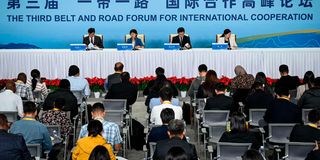BRI drives China-Africa exchange of knowledge

A press conference of the Belt and Road Forum at National Convention Center, Beijing, on October 16, 2023.
What you need to know:
- Besides fostering its human resources capacity, the exchanges have also opened pathways for close interactions between Chinese and African counterparts.
- African countries now have an opportunity to work with China to deliver more impactful partnerships around science, technology and innovation.
The Belt and Road Initiative (BRI) was rolled out by China in 2013 to promote global integration using five pillars: Trade, infrastructure construction, financial inclusion, policy coordination and cultural amity.
As the landing node for the 10-year-old BRI in East Africa, Kenya has had huge success in implementing it. But while much of the discourse on that has focused on infrastructure construction, Nairobi has made strides in consolidating strong educational, scientific and technological exchanges with China.
In 2013, China and Kenya signed cooperation agreement to establish the Sino-Africa Joint Research Centre (Sajorec), a talent cultivation and scientific research platform to help Africa to address its development challenges.
Hosted by Jomo Kenyatta University of Agriculture and Technology (JKUAT), it is equipped with a wide array of technologies and equipment to aid targeted research in areas such as biodiversity conservation, precision agriculture and natural products development.
Chinese technologies
A decade later, Sajorec has provided the space for African and Chinese scientists to collaborate, innovate and transfer technologies to communities. Kenya’s food security, wildlife conservation and public health efforts have all benefited from the research.
The modern agricultural demonstration area in Sajorec has piloted Chinese technologies on crop production using local maize varieties, with over 50 per cent increase in yields. Other advances — curing post-harvest loses, water resource management and sustainable land use — promise to anchor sustainable and beneficial agricultural activity in Africa.
Agriculture is a key pillar in China’s poverty alleviation programme. With just 11 per cent of arable land, it feeds more than 1.4 billion people, or 18 per cent of the world population. Through Sajorec, Africa — home to 65 per cent of the world’s uncultivated and arable land — can learn from China to achieve food security and power industrialisation.
Sustainable development
Sajorec has been a great platform to train a new breed of young African experts in partnership with Chinese universities with hundreds of African students awarded master’s and doctorate scholarships in various science disciplines.
Besides fostering its human resources capacity, the exchanges have also opened pathways for close interactions, improving intercultural understanding between Chinese and African counterparts. Scientific and technological exchanges are key to economic transformation and sustainable and equitable development.
African countries now have an opportunity to work with China to deliver more impactful partnerships around science, technology and innovation and also cultural and educational exchanges.
Another opportunity is on the internationalisation of Chinese companies in different sectors. African youth have the opportunity to learn about the technologies, ideas and attitudes that have enabled and anchored China’s rise and subsequent comprehensive collaborations with African countries.
Dr Cavince is a scholar of international relations with a focus on China-Africa development cooperation. @Cavinceworld





